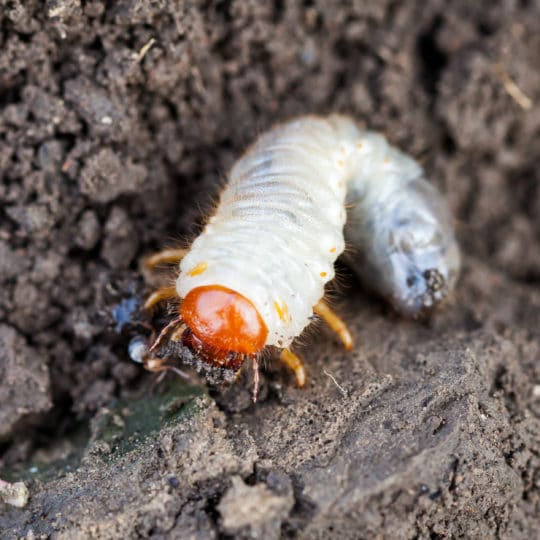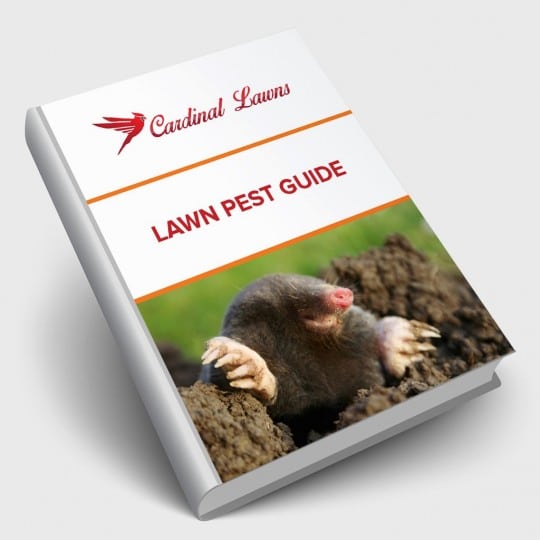Common Fall Lawn Pests
And How To Deal
Posted
October 20, 2022

While the dip in temperature may be sending some pests away, others are still around and ready to do some damage to your yard. Here’s a list of some common fall lawn pests and control options for each.
Common Fall Lawn Pests
You may think summer is the height of bug season with the number of bees, beetles, and other insects flying around. But fall is the season for pests that spend time in your soil. These pests are either finding a warm spot for winter or simply dining on grass. Unfortunately, they’re also tearing apart your lawn. The best line of defense is dealing with them before they grow and become a bigger issue.
Dealing With Grubs & Leatherjackets
If you noticed a lot more beetles around this summer, chances are there are a lot more grubs in your lawn this fall. On top of turning leaves into skeletons, beetles also lay their eggs in your lawn over the summer. Once the larvae hatch, they become grass root-chomping grubs. You’ll notice brown patches of grass in your yard that lifts easily from the soil. You may also notice a lot more wildlife—like birds, moles, and skunks—digging around the dirt.
Check the dead areas of your grass to see if there are any white, C-shaped grubs squirming around. If there are one or two you don’t have to worry. If there are five or more per square foot, it’s time for treatment.
There are both natural and chemical grub control solutions available at most lawn and garden stores. The best way to deal with them is to prevent them. Even if you see one or two, you may want to consider applying a preventative pesticide before more eggs, grubs, and beetles appear. Reseed the dead spots with grub-resistant cool-season grass varieties like tall fescue. Try not to water your lawn so much since beetles prefer moist soil conditions. Fertilize in the fall to help encourage healthy root development and strengthen its defenses.
Leatherjackets are fall-loving larvae of crane flies that feed on grass for months before they overwinter. Similar to grubs, you’ll see dead patches of grass or more wildlife predators on your lawn. Treat your lawn if you find more than two dozen in one square foot.
Dealing With Chinch Bugs
Tiny, dark, winged chinch bugs are active in the spring and fall. Not only will they feed on your grass until winter, but they’ll leave a sticky substance behind that also kills the grass. Discolored, dead grass is a sign that could be mistaken for drought. But if your grass is getting regularly watered, check for bugs.
There are also natural and chemical solutions to rid your lawn of these pests as well. Any preventative measures should be taken in the spring. Regular maintenance, such as proper watering, mowing, and fertilizing can also help prevent any pest problems.
Dealing With Worms
While some worms are great for your soil, other species will kill your lawn. Armyworms are more like caterpillars and move in large numbers to feed on your grass and plants. They appear in late spring, early summer, and early fall. You may notice the tips of the grass blades appear transparent or there are dead and bare spots around your lawn. There are natural and chemical solutions for getting rid of them as well. Catching them early makes it easier to deal with, and regular lawn maintenance—especially removing grassy weeds—is a great way to prevent an infestation.
Cutworms are another caterpillar-like pest that can strike any time of year. You’ll notice small holes in your lawn. These are their burrows. The grass will also be sheared or wilted. Regular lawn maintenance and preventative measures will cut down on large infestations, and there are also natural and chemical treatment options.
Sod webworms grow into a light brown moths that you may notice before you catch the larvae eating your grass. They feed in early summer and early fall. One major sign is silk webbing and tiny green pellets on top of the soil. Look into natural or chemical solutions if you find a dozen or more worms in one spot. Dethatch your lawn to knock out a prime spot for them to hide.
Dealing With Mole Crickets
Mole crickets got their name from their cricket-like bodies and mole-like need to dig tunnels underground. In fact, you may notice their long, thin mounds across your lawn and patches of dead grass. Like many of the other burrowing pests, they’re most active in spring and fall. Insecticides work to help treat and prevent infestations. Plan on applying a long-term product before their eggs hatch in the summer.
Preventing Common Fall Lawn Pests
One thing all of these pests have in common—other than loving your lawn—is how you can prevent them from loving your lawn. Regularly maintain your lawn so it’s not too dry, not too moist, and thickly healthy. It seems easier said than done, but once you get in the habit of noticing when your lawn needs water, mowing, dethatching, reseeding, and fertilizing, you’re left with a lusher lawn.
The fall is an ideal time for aerating, reseeding, and fertilizing. While you may not see the results of a healthier lawn immediately, you’re doing your part to prep it for surviving the winter, thriving in the spring, and standing up to pests all year long.

Download Your FREE Lawn Pest Guide
Pests become most prevalent during the heat and humidity of summer. Take some time to learn about the signs of infestations before any damage can be caused to your landscape. This handy guide will teach you how to spot common lawn pests and how to keep them from causing harm to you and your property.